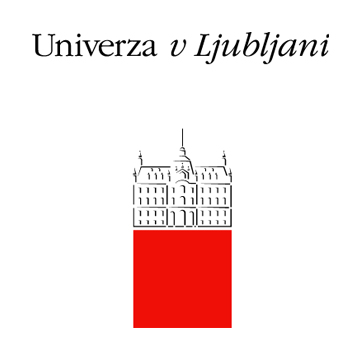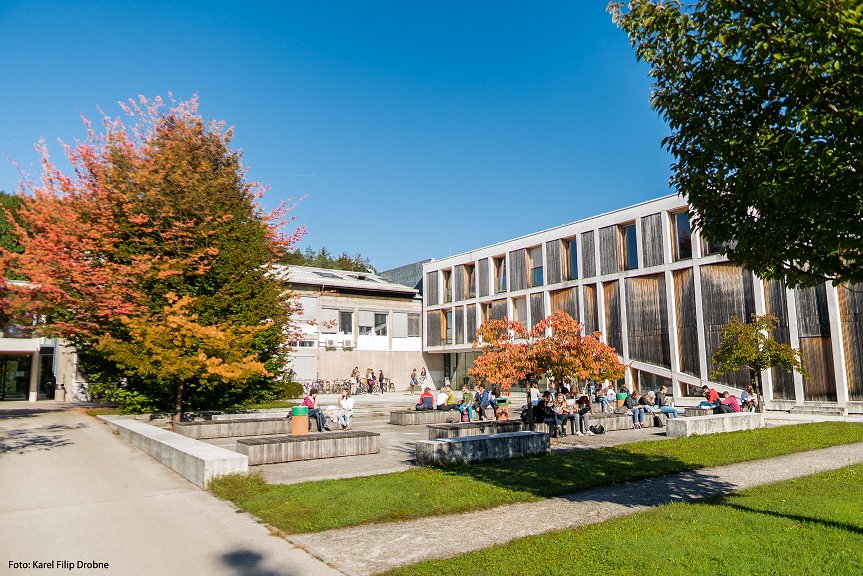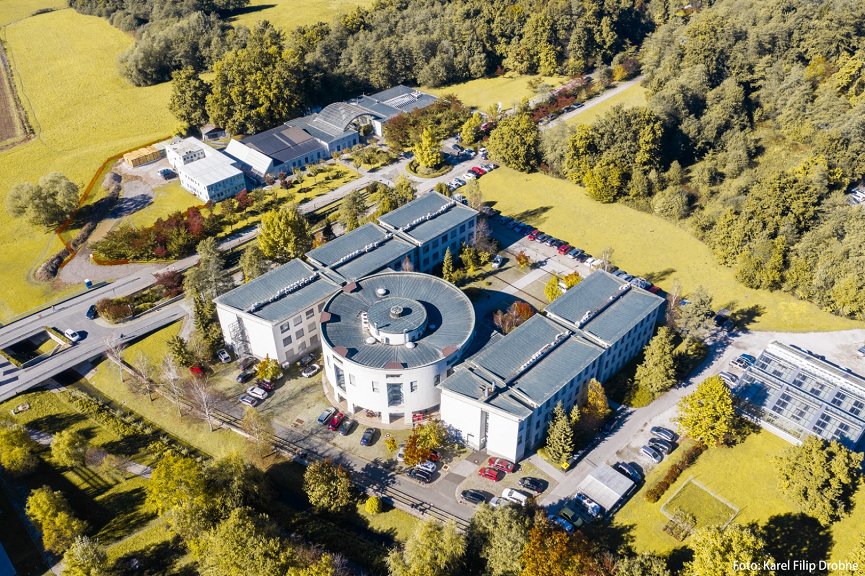University of Ljubljana
Contacts
University of Ljubljana, Biotechnical Faculty
- Cene Fišer
cene.fiser@bf.uni-lj.si
- Cene Fišer
University of Ljubljana joined LifeWatch Slovenia in 2015 and it contributes to LifeWatch ERIC through its National Distributed Centre. The University of Ljubljana is the oldest and the largest university in Slovenia. Within the consortium LifeWatch it is represented by Biotechnical Faculty, Department of Biology, and covers two main activities, education and research. Student training comprises courses in zoology, botany, ecology, behavior and evolution within the BSc and MSc programs. Research covers evolution and ecology of surface and subterranean ecosystems.

Research

We aim to understand biological patterns and processes at all hierarchical levels of biological organization, from an individual to ecosystem. The studied organisms are mainly but not exclusively aquatic macrophytes, leeches, spiders, butterflies, bats, as well as subterranean crustaceans, subterranean beetles and olm.
On a population-level we study adaptation, speciation and dispersal. Local adaptation is a ubiquitous phenomenon in nature. Organisms distributed along ecological gradients, such as surface-subterranean gradient, or organisms living in the intermittent karstic lakes and streams are fantastic model systems for study of adaptation.
Dispersal is studied by population genetics, mainly in various subterranean organisms. Dispersal maintains geneflow between populations; upon cessation of the geneflow speciation unfolds. We study in what circumstances new species emerge, but also describe new species using molecular and morphological tools.
On a species-level, we try to disentangle the role of ecological and historical determinants of species’ distribution by modelling species’ ecological niche and reconstructions of ancient species ranges. On a community and ecosystem level, we study biodiversity patterns, how they correlate with environmental factors and through which processes communities assembled.
Processes are inferred from the ecological, morphological and spatial data within the phylogenetic context. Such macroevolutionary studies shed light onto diversification processes and how they contributed to present-day biodiversity patterns and how this relates to species conservation.
Part of our research comprises applicative outreach in which we are developing monitoring protocols, monitor for selected species and habitats including invasive species, and assess toxicity of different chemicals. We also make assessments of species’ endangerment status according to IUCN.

Projects

LifeNarcIS
NarcIS or the Nature Conservation Information System is a project funded by LIFE programme. Within the project a consoritum of eight project partners will establish the backbone of a modern and digital nature conservation information system. The system addresses the gap that has arisen in the field of nature management data management in the last 15 years.

Life-IP Natura.si
LIFE-IP NATURA.SI – NATURA2000 (gov.si) LIFE Integrated Project for Enhanced Management of Natura 2000 in Slovenia (LIFE-IP NATURA.SI) is managed by Ministry of the Environment and Spatial Planning in cooperation with 14 partners. The project predominantly aims at enhancing the management of Natura 2000 in Slovenia in cooperation with various sectors and stakeholders.
See information about our RI-SI-LifeWatch equipment.
We contribute to RI-SI-LifeWatch in four segments.
We monitor environmental abiotic parameters
For this purpose, we have three planted multimeter dataloggers. With two dataloggers we continuously monitor water quality at sites populated with white and black olm, in Cave Planinska jama and at the spring of Jelševnik, respectively. Both dataloggers continuously monitor water quality, track pollution events and allow interventions at sites in a near-real time. An additional datalogging system measures soil temperature and moisture at intermittent Lake Cerkniško jezero. For regular fieldwork around Slovenia, we have an additional multimeter measuring water quality.
Floristic, faunistic and taxonomic work
The overarching goal of this segment is to complete inventories of selected groups of Slovenian flora and fauna. We are curating the database of aquatic macrophytes from all around Slovenia, including invasive species, as well as the database of subterranean animals, with emphasis on crustaceans and beetles. Field work regularly unveils new, yet undescribed species. Such species are studied morphologically, genetically and, whenever possible, ecologically. New species are diagnosed, described and named. Within this segment of research, we gather data on species’ distribution, species’ ecology and biology, which are essential ingredients needed for the assessment of species vulnerability as well as protection.
We study biodiversity patterns, relate them to historical events and ecological factors, as well as to putative threats
We quantify different facies of biodiversity, namely species, phylogenetic and functional diversity. Quantification of phylogenetic diversity is limited to few selected taxa, like leeches, beetles and amphipods. As part of consortium ERGA-Slovenia (European Reference Genome Atlas) we are progressing from few-loci phylogenies towards genome-wide phylogenies. Functional ecology is studied mainly through functional morphology, i.e. traits which function can be related to fitness. To quantify functional traits, we employ a broad variety of visualization techniques, from optical and electron microscopy to microCT.
All the data gathered in databases are used also in conservation analyses
Present efforts are oriented in the development of biological monitoring of subterranean organisms. Here, we work on i) completion of barcoding libraries for routine species identification, ii) identification of subterranean regions that should be monitored, iii) protocols for field work and iv) identification reference status of present communities for interpretation of future monitoring.
Publications
2024
1. FIŠER, Cene , BOGATAJ , Urban, BRAČKO, Gregor, DELIĆ, Teo, FIŠER, Žiga, KOSTANJŠEK, Rok, VEROVNIK, Rudi, VITTORI, Miloš, ZAKŠEK, Valerija. 2024. 3D Atlas členonožcev, https://www.3datlas.si/.
FIŠER, Cene, PREMATE, Ester (2024). Phenotype Variation in Niphargus (Amphipoda: Niphargidae): Possible Explanations and Open Challenges. Diversity 16 (7), 375. https://www.mdpi.com/1424-2818/16/7/375
PREMATE, Ester, FIŠER, Žiga, BIRÓ, Anna, COPILAŞ-CIOCIANU, Denis, FROMHAGE, Lutz, JENNIONS, Michael, BORKO, Špela, HERCZEG, Gábor, BALÁZS, Gergely, KRALJ-FIŠER, Simona*, FIŠER, Cene * (2024). Sexual dimorphism in subterranean amphipod crustaceans covaries with subterranean habitat type. Journal of Evolutionary Biology 37(5): 487–500 (*equal contribution). https://academic.oup.com/jeb/article/37/5/487/7628557
PREMATE, Ester, FIŠER, Cene (2024). Functional trait dataset of European groundwater Amphipoda: Niphargidae and Typhlogammaridae. Scientific Data 11: 188. https://www.nature.com/articles/s41597-024-03020-w
MALEK-HOSSEINI, Mohammad Javad, BRAD, Traian, FATEMI, Yaser, KUNTNER, Matjaž, FIŠER, Cene (2024). A New Cave-Dwelling Hadzioid Amphipod (Senticaudata, Hadzioidea, Melitidae) from Sulfidic Groundwaters in Iran. Contributions to Zoology 93(2): 107-126. https://brill.com/view/journals/ctoz/93/2/article-p107_001.xml
KRAVANJA, Marija, GERM, Mateja. Distribution of macrophytes in two tributaries of the karstic River Ljubljanica, Obrh and Rak. Folia biologica et geologica. 2024, vol. 65, iss. 2, str. 207-242. ISSN 2335-2914. https://ojs.sazu.si/folia_bio_geo/article/view/8063, DiRROS – Digitalni repozitorij raziskovalnih organizacij Slovenije, DOI: 10.3986/fbg0111.
2023
GERM, Mateja, GOLOB, Aleksandra, ZELNIK, Igor, KLINK, Agnieszka, POLECHOŃSKA, Ludmiła. Contents of metals in sediments and macrophytes differed between the locations in an Alpine lake revealing human impacts : a case study of Lake Bohinj (Slovenia). Water. Apr. 2023, vol. 15, iss. 7, str. [1]-14, ilustr., zvd. ISSN 2073-4441. https://doi.org/10.3390/w15071254, https://repozitorij.uni-lj.si/IzpisGradiva.php?id=145047, DOI: 10.3390/w15071254. [COBISS.SI-ID 147304195]
GERM M., GOLOB A., ZELNIK I., KLINK A., POLECHOŃSKA L. (2023) Diversity of macrophytes and differences in the contents of metals between macro-phyte species in alpine Lake Bohinj (Slovenia). In: Teubner K., Trichkova T., Cvijanović D., eds. Tackling present and future environmental challenges of a European riverscape. IAD Proceedings, 1:8076263. DOI: 10.5281/zenodo.8076263
KNÜSEL, Mara, BORKO, Špela, ALTHER, Roman, SALUSSOLIA, Alice, ALTERMATT, Florian, SALUSSOLIA, Alice, FIŠER, Cene, STOCH, Fabio. Phylogenetic structure and molecular species delimitation hint a complex evolutionary history in an Alpine endemic Niphargus clade (Crustacea, Amphipoda). Zoologischer Anzeiger. Sep. 2023, vol. 306, str. 27-36. ISSN 0044-5231. https://www.sciencedirect.com/science/article/pii/S0044523123000670?via%3Dihub, DOI: 10.1016/j.jcz.2023.07.001. [COBISS.SI-ID 174245635]
MALEK-HOSSEINI, Mohammad Javad, BRAD, Traian, FATEMI, Yaser, KUNTNER, Matjaž, FIŠER, Cene. A new cave-dwelling hadzioid amphipod (Senticaudata, Hadzioidea, Melitidae) from sulfidic groundwaters in Iran. Contributions to zoology. 2023, str. 1-20, ilustr. ISSN 1383-4517. https://brill.com/view/journals/ctoz/aop/article-10.1163-18759866-bja10054/article-10.1163-18759866-bja10054.xml, DOI: 10.1163/18759866-bja10054. [COBISS.SI-ID 174245891]
OJDANIČ, Nik, GERM, Mateja, ANDLOVIC, Maša, ČERNELA, Dorotej, ZELNIK, Igor. Distribution of aquatic macrophytes in the littoral of Lake Bohinj (Slovenia). Diversity. 2023, vol. 15, iss. 11, str. 1-15, ilustr. ISSN 1424-2818. https://www.mdpi.com/1424-2818/15/11/1115, DOI: 10.3390/d15111115. [COBISS.SI-ID 170636547]
OJDANIČ, Nik, ZELNIK, Igor, HOLCAR, Matej, GABERŠČIK, Alenka, GOLOB, Aleksandra. Contrasting dynamics of littoral and riparian reed stands within a wetland complex of Lake Cerknica. Plants. Mar. 2023, vol. 12, iss. 5, str. [1]-20, ilustr., zvd. ISSN 2223-7747. https://doi.org/10.3390/plants12051006, DOI: 10.3390/plants12051006. [COBISS.SI-ID 142918403]
PREMATE, Ester, BORKO, Špela, ALTERMATT, Florian, FIŠER, Cene. Context-dependent evolution of high trophic position drives functional disparity in subterranean crustaceans. Functional ecology: Elektronski vir. [Online ed.]. 2023, vol. 37, iss. 9, str. 2523-2534, ilustr. ISSN 1365-2435. https://besjournals.onlinelibrary.wiley.com/doi/10.1111/1365-2435.14407, https://repozitorij.uni-lj.si/IzpisGradiva.php?id=152606, DOI: 10.1111/1365-2435.14407. [COBISS.SI-ID 159684355]
PREMATE, Ester, KEPIC, Tinkara, FIŠER, Cene. Is the relationship between body length and body mass consistent across habitats? A case study on Niphargus (Crustacea: Amphipoda). Zoology. [Print ed.]. 2023, vol. 161, article 126120, str. 1-6. ISSN 0944-2006. https://www.sciencedirect.com/science/article/pii/S0944200623000545?via%3Dihub, https://repozitorij.uni-lj.si/IzpisGradiva.php?id=153142, DOI: 10.1016/j.zool.2023.126120. [COBISS.SI-ID 164076291]
2021
Premate E*, Borko Š*, Kralj-Fišer S, Fišer Ž, Jennions M, Balazs G, Biro A, Bračko G, Copilaş-Ciocianu D, Hrga N, Herzeg G, Rexhepi B, Zagmajster M, Zakšek V, Fromhage L*, Fišer C* (2021). No room for males in caves: female biased sex ratio in subterranean amphipods of the genus Niphargus. Journal of Evolutionary Biology, 34(10): 1653-1661. https://doi.org/10.1111/jeb.13917.
